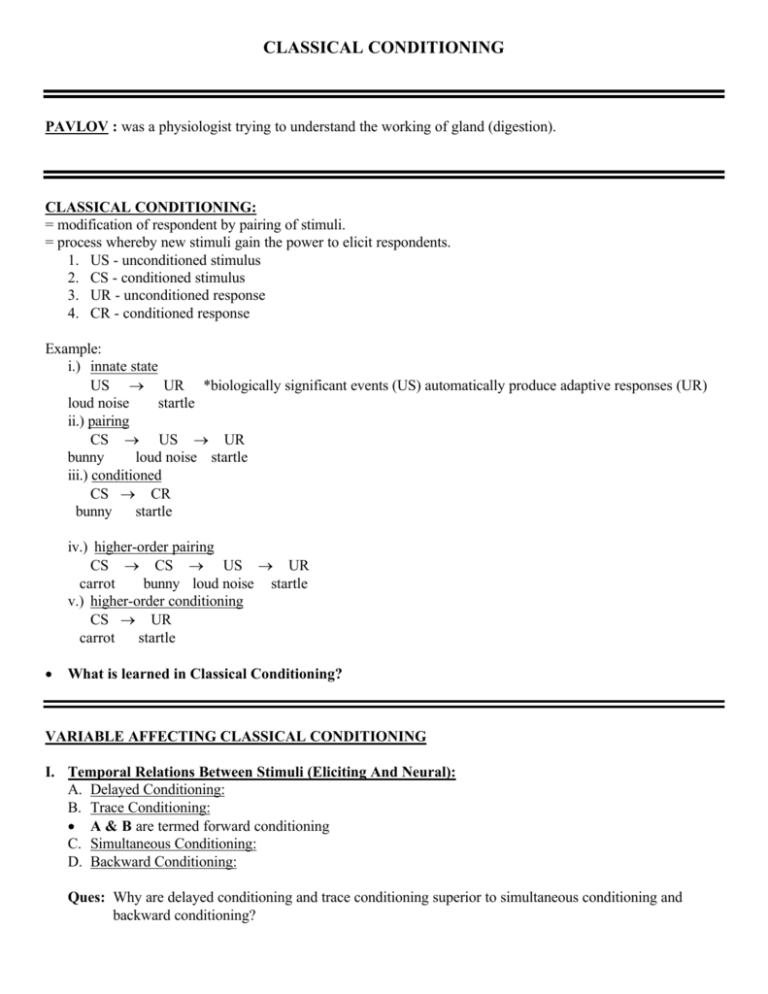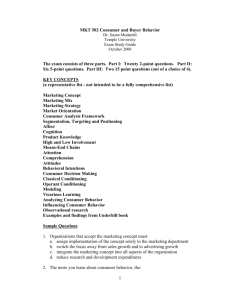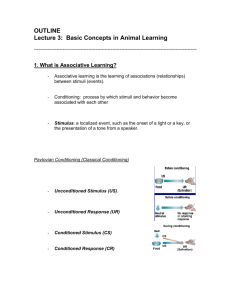CLASSICAL CONDITIONING
advertisement

CLASSICAL CONDITIONING PAVLOV : was a physiologist trying to understand the working of gland (digestion). CLASSICAL CONDITIONING: = modification of respondent by pairing of stimuli. = process whereby new stimuli gain the power to elicit respondents. 1. US - unconditioned stimulus 2. CS - conditioned stimulus 3. UR - unconditioned response 4. CR - conditioned response Example: i.) innate state US → UR *biologically significant events (US) automatically produce adaptive responses (UR) loud noise startle ii.) pairing CS → US → UR bunny loud noise startle iii.) conditioned CS → CR bunny startle iv.) higher-order pairing CS → CS → US → UR carrot bunny loud noise startle v.) higher-order conditioning CS → UR carrot startle • What is learned in Classical Conditioning? VARIABLE AFFECTING CLASSICAL CONDITIONING I. Temporal Relations Between Stimuli (Eliciting And Neural): A. Delayed Conditioning: B. Trace Conditioning: • A & B are termed forward conditioning C. Simultaneous Conditioning: D. Backward Conditioning: Ques: Why are delayed conditioning and trace conditioning superior to simultaneous conditioning and backward conditioning? II. CS-US CONTINGENCY AND CS-US CONTIGUITY: A. CS-US Contingency B. CS-US Contiguity III. EXTINCTION • Technically, extinction is defined as the gradual decrease in the performance of conditioned response that results from CS-alone occurrences. A. Extinction does NOT result from forgetting: B. Whatever is learned during conditioning is not erased during extinction 1. Rapid reactivation 2. Spontaneous Recovery C. Other Theories Of Extinction in response to spontaneous and rapid reactivation 1. Inhibition theory 2. During extinction the animal stops paying attention or attending to the CS 3. Uncertainty IV. PREPARATORY RESPONSE THEORY: A. Drug Tolerance and Compensatory CR 1. Tolerance 2. Compensatory CR 3. Pharmacological Explanation of Tolerance 4. Siegel (1975) B. Siegel (1975): 3 groups of rats 1. Saline Solution Injection for 4 trials: 2. Morphine Injection in same cage for 4 trials: 3. Morphine Injection in same cage for 3 trials and different cage on 4th trial:. ----- CLASSICAL CONDITIONING OUTSIDE THE LABORATORY ---I. CLASSICAL CONDITIONING (CC) IS RELEVANT TO BEHAVIOR OUTSIDE THE LABORATORY IN AT LEAST TWO WAYS: A. It offers a means of understanding behaviors we usually call involuntary behaviors that are automatically elicited by certain stimuli whether we want them to occur or not. 1. Many emotional reactions seem to fall into this category as well as taste aversions. 2. Introspection of your own emotions should demonstrate that emotional reactions are frequently triggered by specific stimuli. II. APPLICATIONS IN BEHAVIOR THERAPY TREATMENT PROCEDURES: A. Mary Carver Jones (1924) and the Beginning of Behavior Therapy. • Eliminating Conditioned Fears (Phobias)- if fears are learned, it should be possible to unlearn or extinguish them. B. Aversive Counterconditioning(ACC): 1. Goal of ACC is to develop an aversive CR to stimuli associated with the undesirable behavior (overeating, excessive drinking, smoking, and drug abuse). C. Systematic Desensitization (SD) for Phobias:







